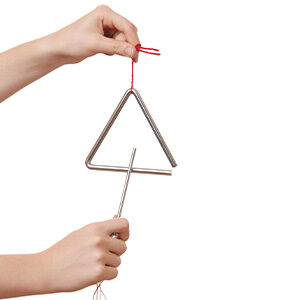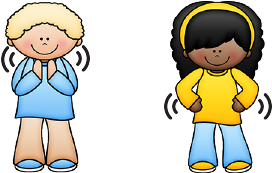Prep. Lesson 19. Rhythm patterns II
Prior learning:
Duration: 30 minutes
Materials: Woodblocks or claves
Keywords: Beat, singing, chanting, partners, rhymes, circle games
Difficulty: ![]()
 Melodic development
Melodic development
![]() Students sing and use body percussion to develop recognition of simple rhythm patterns.
Students sing and use body percussion to develop recognition of simple rhythm patterns.

- To foster rhythm comprehension, implement the following steps:
- Select a familiar song: Choose a song that students have previously learned and are confident in singing. "Bye Lo" is a good example.
- Sing and feel the beat: Encourage students to sing with you, focusing on the song's underlying beat.
- Introduce the concept of rhythm: Explain that the pattern created by the words and their timing is called "rhythm." and is the way the words go!
- Clap to the beat: As students sing, have them clap to the beat, reinforcing the connection between rhythm and the lyrics.
- Demonstrate the rhythm: Repeat the song, clapping the rhythm of the words, and illustrate how it coincides with the beat.
- Combine singing and clapping: Encourage students to sing and clap the rhythm simultaneously, ensuring accuracy and consistency in their performance.
- Support struggling students: Offer guidance and encouragement to those who find the task challenging, emphasising the significance of rhythm in music.
- This structured approach helps students develop their ability to synchronise actions with musical rhythm and lays a strong foundation for future musical growth.
- Engaging in rhythmic exercises also enhances listening skills, coordination, and overall musicianship.
Extension
- When students are secure with clapping the rhythm, divide the class in two.
- One half will keep the beat on their laps, while the other half will clap the rhythm of the words.
- Ask students if there is another body part to show the rhythm. Answers might include patting the knees or head.
- If time permits, swap the activity for each half of the class.
 Game
Game
![]()
Students perform a series of rhythmic movements and sing a much-loved song full of movement.
- Reinforcing students' ability to synchronize movements with the beat is essential for developing rhythmic proficiency.
- Repeated song practice and corresponding actions help students internalise the rhythm and improve coordination.
- The song and its sequence of movements should be introduced clearly, with students arranged in a circle for maximum engagement.
- Students should concentrate on performing the actions while singing as a group, enhancing their ability to work collectively.
- The activity consists of five verses, each with unique movements:
- Verse one: One fist gently taps a leg.
Verse two: Both fists tap legs.
Verse three: Both fists tap legs; one-foot stomps.
Verse four: Both fists tap legs; both feet stomp alternately.
Verse five: Both fists tap legs; both feet stomp alternately; heads nod. - In the final line, students mimic sleeping, resting their heads on their palms. This engaging exercise develops coordination and rhythmic understanding and fosters group collaboration, an essential skill for musicians.
 Rhythmic development
Rhythmic development
![]() Students learn and practice a rhyme with an emphasis on rhythm patterns.
Students learn and practice a rhyme with an emphasis on rhythm patterns.
Lyrics
Ladybird, ladybird, fly away home,
Your house is on fire, your children are gone.
All except one, and her name is Anne,
And she hid under the frying pan!
- To effectively teach beat and rhythm partwork using a rhyme, follow these steps:
- Recite the rhyme multiple times, ensuring that students are well-acquainted before introducing beat and rhythm exercises.
- Seat the students and separate them into two groups to focus on different musical aspects.
- Have one group maintain the beat by tapping their knees (patsch) while the other group claps the rhythm, following the words of the rhyme.
- Ensure both groups can accurately perform their tasks before proceeding.
- Once students have mastered their initial tasks, switch the groups' roles so that they gain experience with both beat and rhythm.
- To add an element of fun and reinforce learning, select a student to act as "Anne" at the end of the rhyme and pretend to hide.
- This structured approach helps students understand beat and rhythm better while encouraging active participation, teamwork, and creativity.
 Part work
Part work
![]() Students use non-tuned percussion to create rhythm patterns.
Students use non-tuned percussion to create rhythm patterns.

- Introduce students to the triangle and woodblock, demonstrating the proper techniques for producing sound from each instrument.
- Show students the correct way to hold a woodblock and use a beater to create a crisp sound.
- Teach students the proper method for holding a triangle and using a beater to generate a pleasing sound.
- Once students are familiar and comfortable with the song "Ickle Ockle," follow these steps:
- Have the class sing "Ickle Ockle" together.
- Invite a volunteer to play the woodblock in time with the beat while the class sings the song.
- Remind students that the arrangement of words in a song is called rhythm, which can also be played on an instrument.
- Play the rhythm of "Ickle Ockle" on the triangle while the class sings.
- Ask volunteers to hold the triangle and play the rhythm. Repeat this process with additional volunteers as time allows.
- This approach combines singing and instrumental play to reinforce students' understanding of beat and rhythm while offering hands-on experience with percussion instruments.


 Farewell
Farewell
![]() Reinforces students' pitch ability through listening, imitation, and repetition. 'Good morning' or 'Bee, Bee, Bumblebee' are good examples.
Reinforces students' pitch ability through listening, imitation, and repetition. 'Good morning' or 'Bee, Bee, Bumblebee' are good examples.
Suggested lessons
Prep. Lesson 20. Body percussion
Students discover how to use their body as an instrument through body percussion. AC9AMUFP01
Prep. Lesson 21. Exploring high and low sounds
Students improve their listening skills and discover more about high and low sounds. AC9AMUFP01


